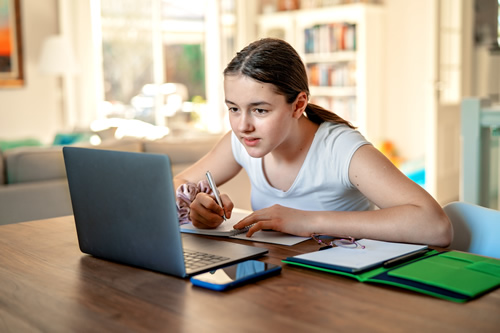The ripple effects of COVID-19 have thrust the world into uncertain times, and especially schools and students. As K–12 educators try to adjust to a new reality, many stories in the media note a tension between maintaining academic expectations while also supporting students’ basic needs during distance learning. But these priorities don’t have to be mutually exclusive.
Students can and should continue their learning during stay-at-home mandates. But getting remote learning to work well requires feedback loops between schools and families. Never have frequent and meaningful check-ins been more important in providing the responsiveness and flexibility required to keep students from falling through COVID-19’s cracks. One of the keys to success for any effective distance learning program is taking into account students’ personal circumstances, such as their home life, home resources, and access to technology.
Related content: Digital teaching for students in special education
But, to ensure check-ins happen, educators need one thing that may be in short supply: capacity. Due to constantly changing and often confusing remote learning instructions, as well as their own home life challenges, educators may struggle with prioritizing time and attention to connect with students in a structured way. Yet, with the right online resources and edtech tools at their disposal, teachers can find ways to focus on both academics and positive relationships.
Online resources for instruction. One way to help teachers claim back the time they would otherwise spend planning and delivering made-from-scratch online lessons is to curate engaging online resources for asynchronous instruction. This may require time upfront—just as migrating existing classroom resources online takes time—but that investment will pay dividends for student interaction. As potential starting points, Khan Academy, cK-12, Actively Learn, and Generation Genius offer fully online, standards-aligned materials loaded with engaging videos, simulations, and practice activities. Crash Course, TED-Ed, and the wide world of YouTube educational videos also cover just about any topic or subject. And if you’re worried about checking for understanding or gauging student engagement, consider loading online videos in edpuzzle—a platform that lets you turn online videos into lessons with embedded questions.
Online resources for practice and feedback. Adaptive platforms that give students opportunities to learn and practice new skills can support student/teacher check-ins in at least two ways. First, they can reduce the number of assignments teachers have to create and grade manually, thereby freeing more time for check-ins. Second, they give teachers real-time data on how students are progressing and where they are struggling, which helps students know who they most need to connect with. For example, Newsela, Lexia CORE5, iReady, and Achieve3000 help students develop early literacy skills. For writing, Khan Academy and Quill provide feedback on students’ understanding of the rules of grammar. And in math, Prodigy, ST Math, Dreambox, iReady, Khan Academy, and Mangahigh are a few go-to sources for practice and feedback.
Online resources for instruction, practice, and feedback cannot and should not completely replace teacher-led instruction. But they can lighten teachers’ loads when it comes to planning and grading so that teachers can focus on areas where their personal instruction and their person-to-person connections with their students are most needed.
Distance learning check-ins. When teachers create more time in their daily schedules for distance-learning check-ins, what might those check-ins look like? Below are a few ideas.
● Class meetings over video: Video conferencing may not be the best medium for direct instruction, but it can be a valuable way to meet as a class just to discuss common experiences and maintain a sense of community.
● Video messaging discussions: To supplement asynchronous instruction, teachers might consider starting a daily class discussion thread through video messages posted to Flipgrid. Discussion topics might center on academic content, or they might just give students opportunities for personal sharing and connection.
● Office hours: Teachers might consider designating a window of time each day when they will be available via messaging, phone calls, or video conferencing to assist students with their asynchronous learning activities.
● Surveys: Teachers might periodically send out a short survey to students and their families via email or text message just to get a quick pulse on how students are getting by and find out where distance learning might be causing struggles.
● Individual calls: As part of their daily schedule, teachers might set aside time to reach out to two or three individual students and their families for one-on-one check-ins. Regular calls to every student and family are a challenge, but it can make sense to prioritize students based on their survey responses or their progress (or lack thereof) in online learning activities.
With COVID-19 upending our communities, this saying rings true now more than ever: “Students don’t care how much you know until they know how much you care.” Most teachers instinctively care about their students—that’s why they chose a teaching career in the first place (I say this with confidence as a former teacher myself). But putting feelings of caring to action is harder from a distance.
Fortunately, with innovative edtech that enhances engagement and expands educator capacity, schooling from a distance can still be a supportive experience.
- 4 ways to encourage play in education - April 25, 2024
- CoSN IT Leader Spotlight: Lisa Higgins - April 25, 2024
- It’s time to pay student teachers - April 25, 2024

